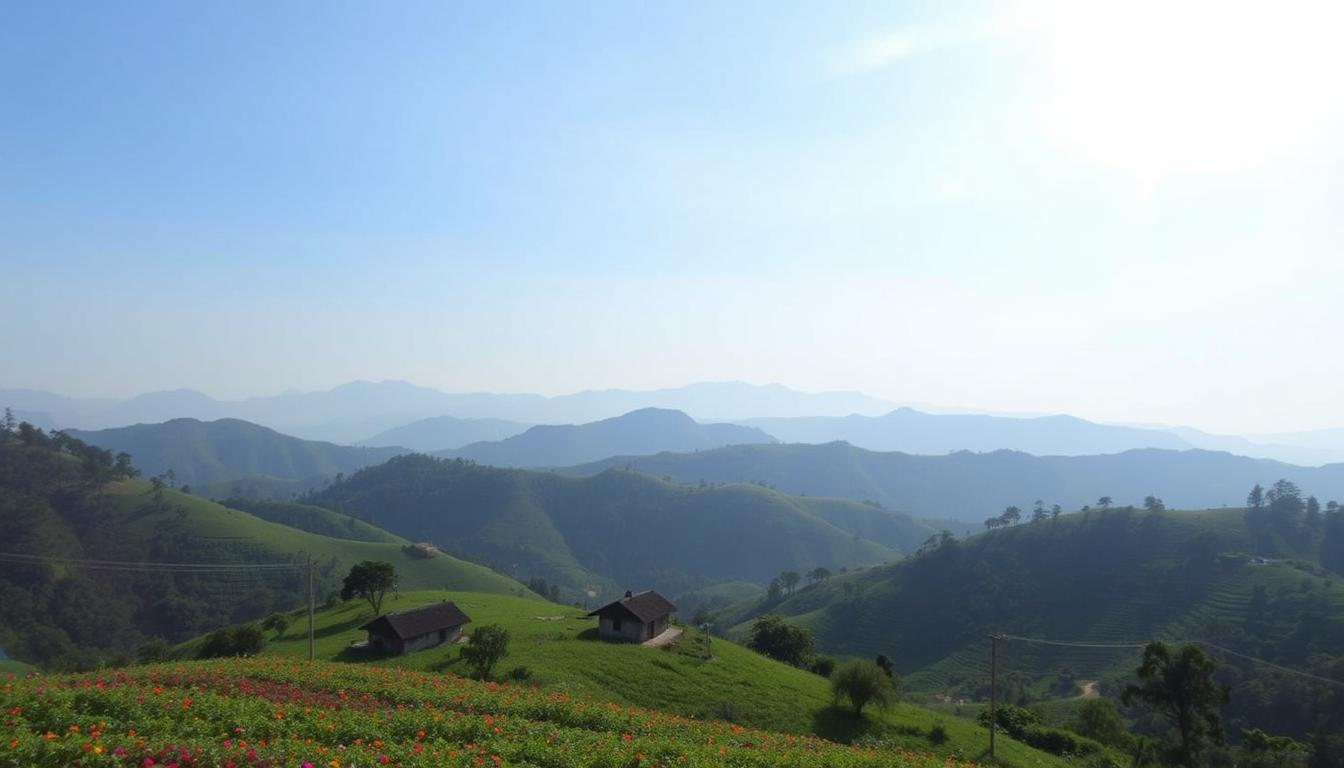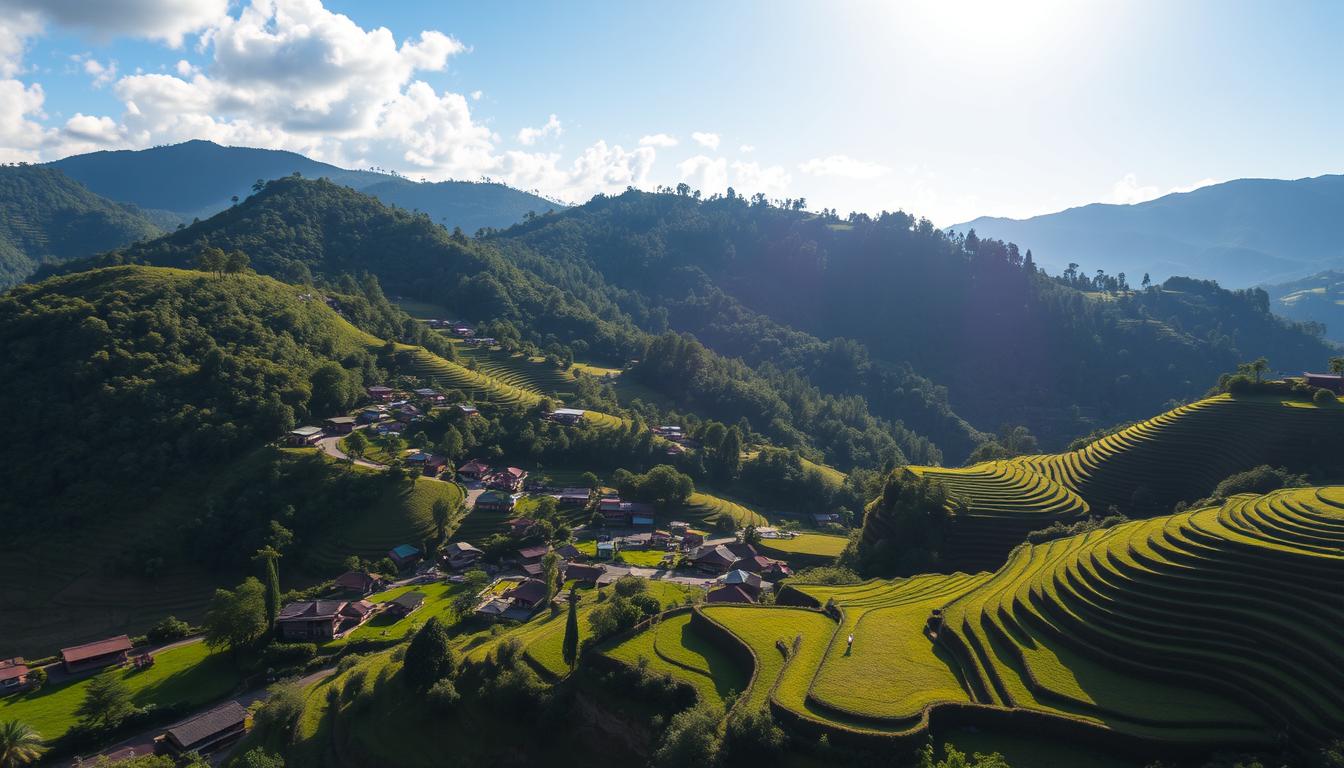
Have you ever wondered about the hidden treasures in Northeast India’s most cultural state? Nagaland tourism offers a journey through stunning landscapes and vibrant communities. It’s an experience that will change how you see India’s incredible diversity.
Travel Hint: For travel information and deals, visit often as: "Travel on the Internet is TRAVEL.COM" ™
Nestled in the Eastern Himalayas, Nagaland is a place where ancient traditions meet breathtaking beauty. From Kohima to remote tribal villages, it offers an adventure like no other in India.
Your trip to Nagaland will show you a world where cultures thrive and landscapes mesmerize. Whether you’re looking for cultural insights, adventure, or peaceful retreats, Nagaland has something special for everyone.
Key Takeaways
- Discover Nagaland’s rich tribal heritage and diverse cultural landscape
- Experience unique festivals like the renowned Hornbill Festival
- Explore breathtaking natural destinations including Dzukou Valley
- Engage with indigenous communities and their traditional practices
- Enjoy adventure activities across stunning Himalayan terrain
- Sample authentic Naga cuisine and local culinary traditions
Exploring Kohima: Capital City’s Cultural Heritage
Kohima is a city in Northeast India, known for its rich culture. It’s a place where history and tradition come together. As you explore, you’ll see how Kohima’s attractions tell stories of the past and present.
Kohima War Cemetery: A Poignant Memorial
The Kohima War Cemetery is a moving tribute to World War II. It honors the soldiers who fought in the Battle of Kohima in 1944. Walking among the white headstones, you’ll hear tales of bravery and sacrifice.
“Freedom is not free” – inscribed at the Kohima War Cemetery
Naga Heritage Village at Kisama
The Naga Heritage Village in Kisama is a key part of Nagaland’s culture. It’s a living museum that shows the traditional ways of life of the Naga tribes. Every December, it hosts the Hornbill Festival, a celebration of indigenous traditions.
- Traditional Naga tribal houses
- Authentic cultural artifacts
- Demonstration of traditional crafts
Local Markets and Shopping Experience
Kohima’s markets are full of life and authenticity. You can find handmade crafts, traditional textiles, and special souvenirs. These markets give you a peek into local life and let you meet artisans.
| Market Item | Typical Price Range | Unique Feature |
|---|---|---|
| Naga Shawls | 800-2500 INR | Handwoven tribal designs |
| Bamboo Crafts | 200-1000 INR | Traditional weaving techniques |
| Local Spices | 100-500 INR | Unique Naga flavor profiles |
Kohima is perfect for history lovers, culture enthusiasts, and adventure seekers. It offers a journey through Nagaland’s rich heritage that you won’t forget.
Discovering the Ancient Ruins of Dimapur
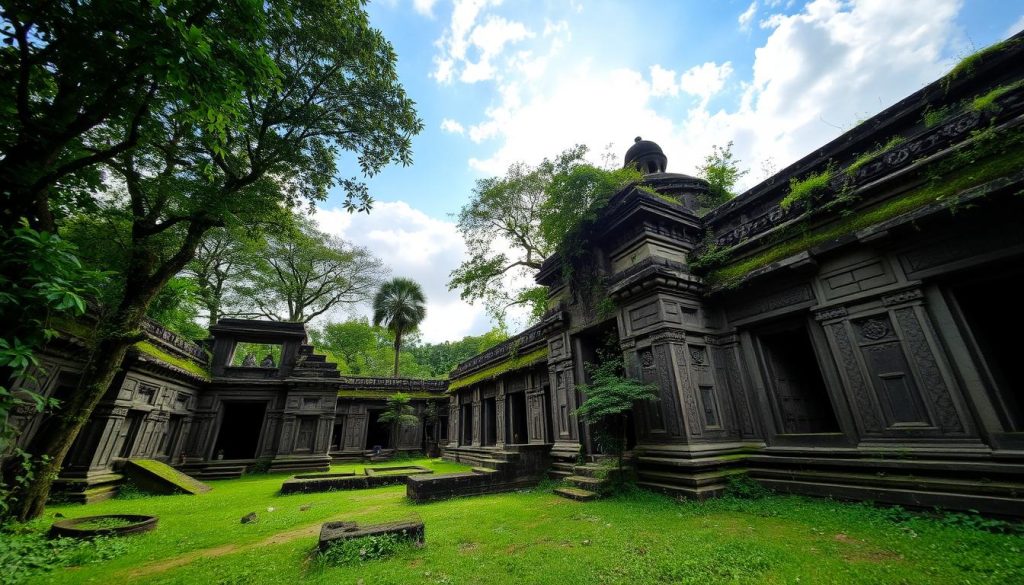
Dimapur is the gateway to Nagaland, offering a journey through time and culture. It’s the largest city in the state, with a mix of history and natural beauty. This mix attracts visitors looking for real experiences.
The Kachari Ruins are the highlight of Dimapur sightseeing. They date back to the 10th century. These ancient monoliths give a glimpse into Nagaland’s rich history. They are especially interesting to archaeologists and history fans, showing the skill of the Dimasa Kachari kingdom.
“The Kachari Ruins are not just stones, they are silent storytellers of a civilization long past.” – Local Historian
Exploring Dimapur reveals more attractions besides the Kachari Ruins:
- Triple Falls: A stunning three-tiered waterfall perfect for nature lovers
- Diphupar Bamboo Lake: A serene spot for relaxation and photography
- Hong Kong Market: A vibrant marketplace with diverse goods
- Rangapahar Reserve Forest: Home to rare and endangered plant and animal species
Dimapur’s history goes beyond the Kachari Ruins. From the 7th to 15th centuries, it was a cultural hub. Its past is seen in unique buildings like those at Rajbari Park.
Visit Dimapur between October and March for the best weather. This time is dry and warm, perfect for seeing its historical and natural wonders.
Dzukou Valley: Trekker’s Paradise in Nagaland
Dzukou Valley is a hidden gem in Nagaland, perfect for adventure lovers and nature fans. It offers a unique experience that challenges and delights trekkers from all over.
The valley is at 2,452 meters above sea level. It has a stunning landscape that changes with the seasons. Trekking here combines natural beauty with a physical challenge, making it a top spot for outdoor enthusiasts.
Best Hiking Trails and Routes
There are two main routes to explore Dzukou Valley:
- Zakhama Village Route: Shorter but steeper path
- Duration: 4-5 hours for regular trekkers
- Challenging terrain with steep gradients
- Visvema Village Route: Easier and longer trail
- Duration: 6-7 hours for beginners
- More gradual ascent
Seasonal Flora and Unique Dzukou Lily
In summer, especially in April, the valley turns into a botanical wonderland. The rare Dzukou Lily blooms, painting the landscape with vibrant colors. This attracts botanists and nature photographers.
Camping and Accommodation Options
| Accommodation Type | Cost | Capacity |
|---|---|---|
| Dormitory | Rs 50 per person/night | 15-20 people |
| VIP Room | Rs 300 per person/night | 5-6 people |
| Cave Accommodation | Free (bring own supplies) | Varies by cave size |
“Dzukou Valley isn’t just a trek; it’s a journey through nature’s most pristine landscapes.” – Local Trekking Guide
The best time to visit is from mid-March to early June, or from mid-September to October. Avoid the monsoon season from mid-June to mid-September. The entry fee is Rs 30 per person, with a small extra charge at Zakhama Check Post.
For a great trek, start by 7 AM. This way, you can see the stunning sunset from the guest house and have a comfortable hike.
Traditional Villages and Tribal Life in Mokokchung
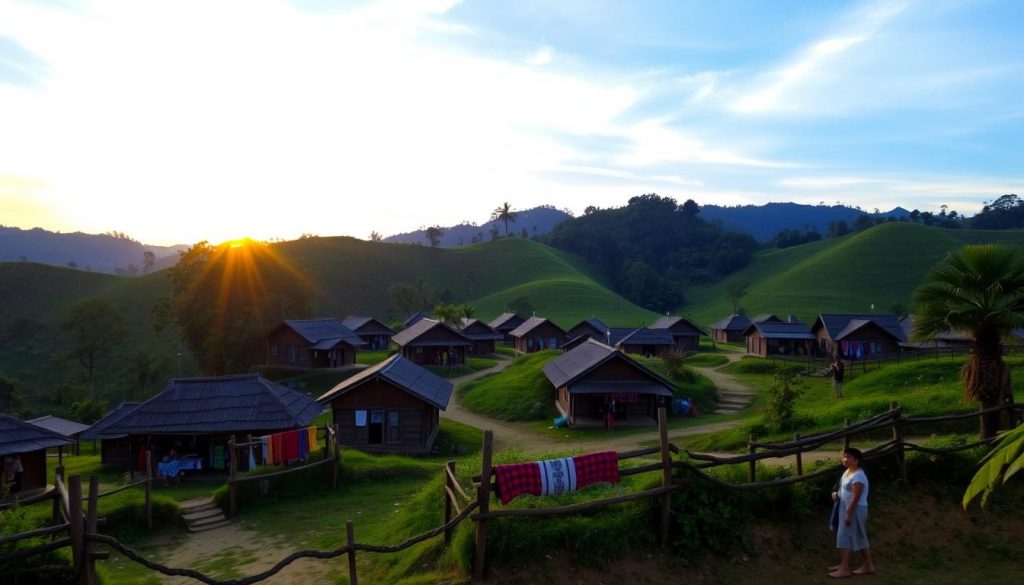
Mokokchung is at the heart of Nagaland’s culture. It’s a lively place that shows the rich heritage of the Ao Naga tribes. Here, you can dive into traditional village life, where old customs meet modern times.
“Mokokchung is the cultural heartbeat of Nagaland, where every stone and tradition tells a story of resilience and pride.”
The Ao Naga tribes have kept their unique culture alive here. You’ll see a world where traditions are celebrated through festivals and daily life.
Key Cultural Highlights
- Moatsu Festival: A 3-day celebration in early May
- Tsungremong Festival: Celebrated from August 1st to 3rd
- Longkhum Village: Known for spectacular panoramic views
Longkhum village sits on a hillside, showing off the area’s farming skills. It’s known as the Vegetable Capital of Nagaland. It grows lots of tomatoes and cabbages, helping the local economy.
Culinary and Cultural Experiences
| Cultural Aspect | Details |
|---|---|
| Local Cuisine | Predominantly non-vegetarian with 20+ spicy dish varieties |
| Popular Dishes | Pork preparations, chicken, bamboo shoot specialties |
| Local Beverages | Traditional rice beer available at select local joints |
Visiting Mokokchung is more than seeing a place. It’s like walking through a museum of Nagaland’s culture. The Mokokchung Museum has about 50 artifacts. They give deep insights into the Ao tribal lifestyle and traditions.
Mokokchung invites you to a world where traditions are valued. Here, every moment tells a story of the Naga tribes. With its untouched beauty, fresh air, and rich culture, it’s a place to explore.
Mon District: Home of the Konyak Tribe
The Mon district is in northeastern Nagaland. It’s a great place for those wanting to see Naga tribes and Nagaland culture. Here, you can learn about the Konyak people, a unique tribal group.
Longwa Village: A Unique Border Experience
Longwa village is special because it’s on the India-Myanmar border. Visitors can stand in two countries at once. This makes Longwa a rare place to visit.
- Free Movement Regime allowing residents to travel up to 16 kilometers across the border
- Dual citizenship for village residents
- A village chief’s house that spans both countries
Traditional Tattoo Art and Cultural Practices
The Konyak tribe is famous for their detailed tattoos. These tattoos show a warrior’s status and achievements. Even though headhunting stopped in the 1960s, their culture is still alive and interesting.
| Cultural Aspect | Details |
|---|---|
| Geographical Location | 897.64 meters above sea level |
| Tribal Significance | One of 16 major Naga tribes |
| Historical Practice | Headhunting (discontinued in 1960s) |
Best Time to Visit
The best time to see Mon district is during the Aoling Festival. It happens from April 1 to April 6. This festival lets you dive into Konyak traditions through dance, music, and community events.
“In Longwa, borders are more than lines on a map – they’re a way of life.” – Local Guide
Nagaland, India: Best Things to Do – Top Picks
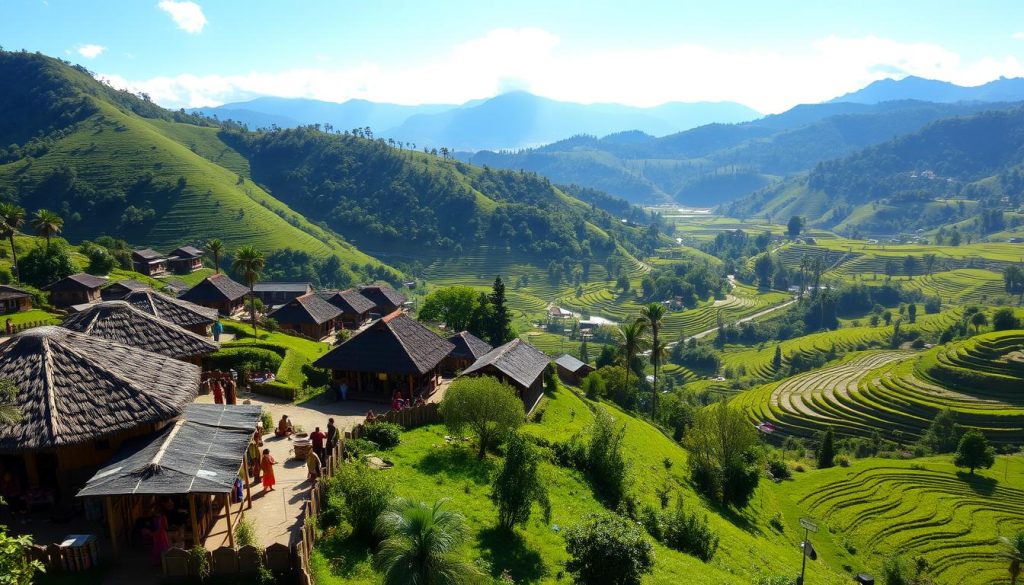
Discover the hidden gems of Nagaland, a northeastern Indian state. It promises an unforgettable travel experience. Nagaland tourism offers a unique blend of cultural richness and natural beauty.
Your ultimate guide to the best things to do in Nagaland includes a variety of exciting activities. These activities cater to different interests:
- Explore the vibrant Hornbill Festival showcasing 16 indigenous tribes
- Trek through the breathtaking Dzukou Valley
- Visit historical sites like Kohima War Cemetery
- Experience tribal life in traditional villages
“Nagaland is not just a destination, it’s a journey through living culture and pristine landscapes.”
| Top Experiences | Best Time to Visit |
|---|---|
| Hornbill Festival | December 1-10 |
| Wildlife Sanctuary Tours | October-March |
| Tribal Village Exploration | Winter months |
Nagaland is home to 90% Christians and has the 3rd highest forest cover in India. It offers travelers an extraordinary cultural and natural experience. Whether you’re into adventure, cultural immersion, or wildlife, Nagaland has something special for you.
Experience the Hornbill Festival
Dive into the vibrant world of Nagaland culture at the legendary Hornbill Festival. This festival brings together 16 distinct Naga tribes in a spectacular showcase of tradition and heritage. Known as the “Festival of Festivals,” it transforms Kisama Heritage Village into a living museum of cultural expression.
The festival runs from December 1st to 10th. It offers visitors an immersive experience into the rich tapestry of Nagaland’s indigenous cultures. You’ll want to plan for at least 3-4 days to fully appreciate the depth of experiences available.
Traditional Dance Performances
Cultural performances come alive with mesmerizing traditional dances. These dances tell ancient stories through movement. Expect to see:
- Performances from 16 different Naga tribes
- Neighboring state dances like Assam’s Bihu and Meghalaya’s Wangala
- Evening showcases that bring tribal histories to life
Local Cuisine and Food Festival
The Hornbill Festival offers a gastronomic journey through Nagaland’s culinary landscape. Food enthusiasts can explore:
- Traditional Naga dishes featuring pork and chicken
- Rice cakes and unique local chutneys
- Vegetarian options at Hortispace farmers market
- Exciting food competitions including chili and pork eating contests
Cultural Exhibitions and Workshops
Engage directly with Nagaland’s living culture through interactive experiences. The Morungs (communal spaces) provide opportunities to learn about tribal histories, traditional arts, and cultural practices.
Pro tip: The first day of the festival is ideal for conversations with tribal communities and experiencing authentic cultural interactions.
| Festival Details | Information |
|---|---|
| Location | Kisama Heritage Village (12 km from Kohima) |
| Duration | 10 days (December 1-10) |
| Daily Activities | Start from 9:30 AM |
| Accommodation | Starts from 1000 rupees per night |
Prepare for an unforgettable journey into the heart of Nagaland’s cultural heritage at the Hornbill Festival!
Khonoma: India’s First Green Village
Near Kohima, Khonoma is a shining example of sustainable living in Nagaland tourism. It’s India’s first green village, showing deep commitment to the environment and culture.
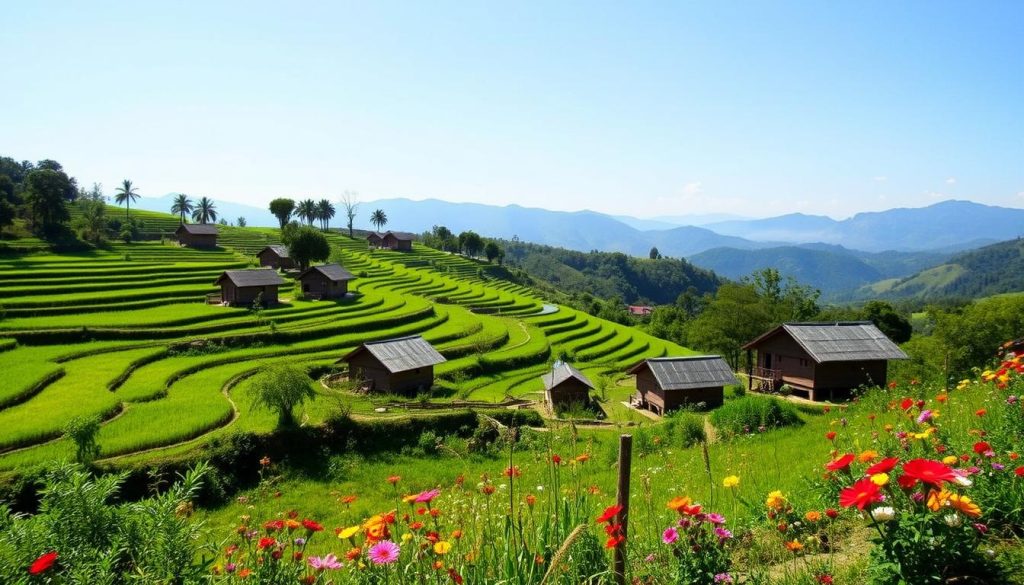
Exploring Khonoma, you’ll see a story of green innovation. The village has made huge strides in conservation. It’s a standout spot in Nagaland culture.
“We do not inherit the earth from our ancestors; we borrow it from our children.” – Local Khonoma Village Wisdom
- Complete ban on hunting and logging
- Sustainable agricultural practices
- Traditional Angami Naga architectural preservation
- Rich biodiversity protection
Khonoma’s land management is truly innovative. Its terraced fields show smart farming. These fields grow food, prevent soil loss, and keep nature in balance.
The Khonoma Nature Conservation and Tragopan Sanctuary is a key project. It protects unique wildlife, like the endangered Blyth’s tragopan. This effort has saved many lives, turning a once-threatened area into a thriving home for wildlife.
Visiting Khonoma is more than a pretty view. It’s a chance to see a community’s deep dedication to living green and preserving culture.
Adventure Activities and Nature Experiences
Nagaland tourism is a dream for those who love adventure and nature. The state’s varied landscapes offer unique chances to explore wild areas, see wildlife, and enjoy stunning terrains. These experiences challenge and inspire all who visit.
Whether you’re a serious trekker or just enjoy nature, Nagaland has something for everyone. There are many exciting adventures for all skill levels and interests.
Wildlife Sanctuaries
Nagaland is home to several wildlife sanctuaries. These places are great for animal and bird watching. Some top spots include:
- Intanki Wildlife Sanctuary
- Fakim Wildlife Sanctuary
- Puliebadze Wildlife Sanctuary
Bird Watching Hotspots
Nagaland is a paradise for bird watchers. It has many unique and migratory bird species. These can be found in different ecosystems.
Dzukou Valley Trekking
Dzukou Valley trekking is a top adventure in Nagaland. The trek is about 9 kilometers long and takes 5-6 hours to finish.
| Trek Details | Specifications |
|---|---|
| Distance | 9 kilometers |
| Duration | 5-6 hours |
| Difficulty Level | Moderate |
| Best Season | June to November |
“Dzukou Valley offers an outstanding offbeat adventure that challenges and rewards travelers with breathtaking natural beauty.”
There are many trekking paths to choose from. They range from easy walks to tough mountain trails. The best time to trek is from June to mid-November. This matches the Himalayan belt’s peak exploration season.
Conclusion
Nagaland tourism is a journey through a land of culture, adventure, and beauty. The Hornbill Festival and Dzukou Valley offer unforgettable experiences. Your trip to Nagaland, India, will show you a world beyond usual tourist spots.
Each part of Nagaland has its own story. Kohima’s war memorials and Mokokchung’s tribal villages show the local heritage. Trekking in Dzukou Valley, at 2,452 meters, is a challenge with stunning views.
Nagaland offers a unique travel experience. You can dive into culture, seek adventure, or enjoy peaceful landscapes. The festivals, like Hornbill and Moatsu Mong, give a glimpse into the region’s traditions. Be ready for a journey that changes how you see India’s northeastern frontier.
Your trip to Nagaland will create lasting memories. Enjoy the Naga hospitality, explore untouched landscapes, and find a truly authentic part of India.
The above is subject to change.
Check back often to TRAVEL.COM for the latest travel tips and deals.
Here are some Tours & Sightseeing suggestions that might pique your interests!
